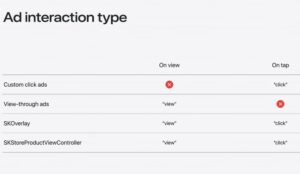AdAttributionKit
What is AdAttributionKit?
AdAttributionKit is Apple’s new mobile advertising measurement and attribution framework.
It is fully compatible with SKAdNetwork, Apple’s first privacy-preserving advertising measurement framework, but it was built for an app ecosystem in which the iOS App Store, owned and operated by Apple, is not the only place to get apps for iPhones and iPads.
Like SKAdNetwork, AdAttributionKit is a framework, not a specific app or single piece of software. It is designed for iOS and iPadOS and will measure ad effectiveness while preserving user privacy. This framework builds on the existing SKAdNetwork system and uses “crowd anonymity” to protect user data.
AdAttributionKit will have two components:
- App AdAttributionKit
- Web AdAttributionKit
We will focus on app and mobile AdAttributionKit for this overview.
Need next-gen advertising measurement in the privacy era?
Singular has the leading measurement suite for iOS, Android, web, and more …
Key components of AdAttributionKit
AdAttributionKit has a strong privacy focus. The new framework, like SKAdNetwork, ensures user privacy by sending less data when there are fewer engagements and conversions while sending more data as the number of engagements increases.
AdAttributionKit supports 3 different ad types:
- Custom click ads, which will take people to an app marketplace
- View-through ads, which will track impressions and views on non-clickable ads like videos
- Store view ads, like SKOverlay which shows a small app listing in an app marketplace, and SKStoreProductViewController, which shows a full-page app listing in an app marketplace.
Click ads can only register clicks, not views. All other ad types can register views, and view-through ads cannot register clicks.
In a first for Apple advertising frameworks, AdAttributionKit will support re-engagement campaigns, where an app is already installed on a user’s phone, but is not in regular use. When an advertiser wants them to re-engage and start actually using it again, the advertiser can now run and measure re-engagement advertising campaigns.
When running re-engagement campaigns with AdAttributionKit, ad clicks will take people right to the specific app that is being advertised.
This will only work with clicks, not views.
How does AdAttributionKit work?
The advertising process using AdAttributionKit is very similar to that with SKAdNetwork.
Publisher apps that display ads will fetch ad data from ad networks, which is provided in a compact JSON Web Signature (JWS) format. They’ll display the ads as they wish, and when people engagement with them either via paying attention or clicking, the publisher apps will fire postbacks that will allow both ad networks and advertisers to gauge the effectiveness of their ad campaigns in a privacy-safe way.
Those postbacks are pretty much the same as SKAdNetwork postbacks, with the following components:
- Publisher identifier (app the ad is shown in)
- Source identifier (ad campaign information)
- Interaction type (click or view)
- Conversion value (fine or coarse)
The data that ad networks and advertisers get, however, is limited by Crowd Anonymity, just like SKAdNetwork. With lots of engagement and app installs, advertisers can get fine conversion values in their postbacks (values from 0-63) and more detail in their Source Identifiers. With fewer installs, advertisers may get just coarse conversion values (low, medium, high) or none at all.
Just like SKAdNetwork, postbacks can be locked, and there are random timed delays in postback delivery.
There is a Developer Mode for easier testing, which speeds up the testing process by removing time randomization and shortening conversion windows and speeding up postback transmission.
Related Terms
Related Articles
- AdAttributionKit: the new SKAdNetwork?
- 3 sources of SKAdNetwork fraud advertisers need to prep for
- 66% of iOS marketers now working on SKAN 4; 5.4% say SKAN 3 is ‘going great’
- 75% of brands still rely heavily on third-party cookies: Adobe study of 2,667 marketers
- 8 insights on media mix modeling for mobile user acquisition from Meta, Tinuiti, Rocketship HQ, and Singular
